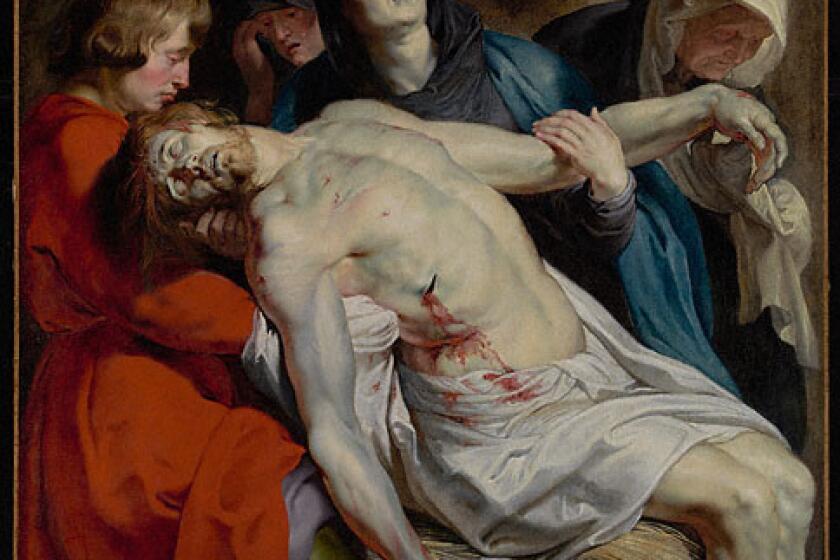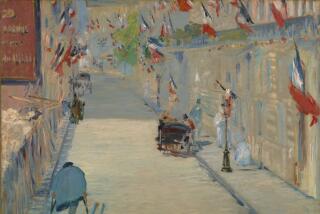Review: The Getty Villa’s gem of a Peter Paul Rubens show
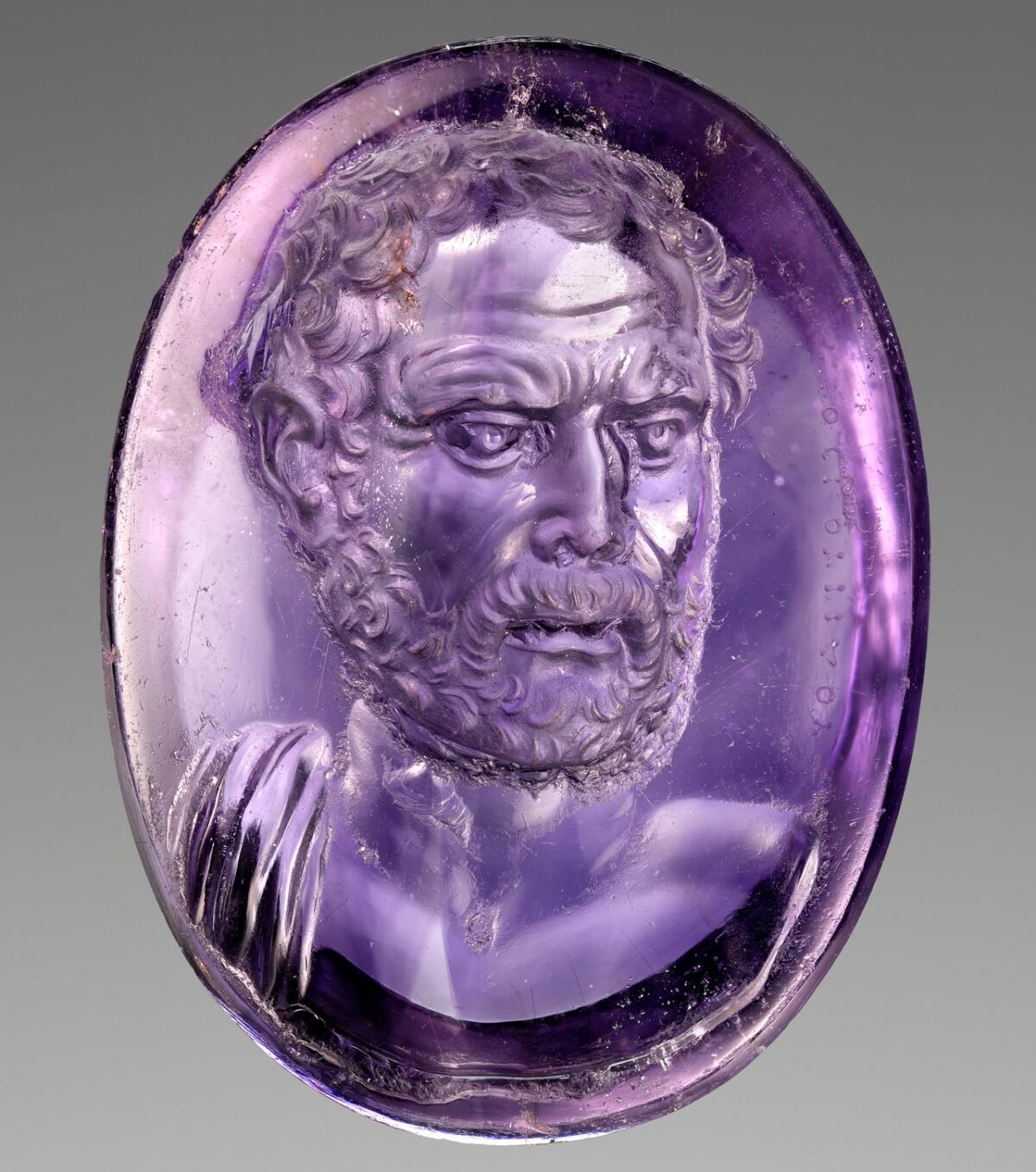
- Share via
Paintings by the Flemish Baroque genius Peter Paul Rubens (1577-1640) are not what one expects to encounter at the Getty Villa in Pacific Palisades. That’s home to the museum’s extensive collections of Greek, Roman and Etruscan art.
Yet, it’s a perfect place to see Rubens’ work. Like many of his compatriots, the painter was mad for ancient art — especially the sculpture of late imperial Rome — and the unexpected Villa context for his work fascinates.
“Rubens: Picturing Antiquity,” the exhibition that opened last month and continues to Jan. 24, is a concise outline of the ways in which the artist exploited the classical past. His aim: to advocate for the aggressive Catholic Counter-Reformation that was roiling 17th century Europe.
Almost two dozen Rubens paintings and oil sketches, plus a selection of chalk and pen-and-ink drawings, have been assembled. Loans have come from the Louvre, the Prado, the Uffizi, the Princely Collections of the Liechtenstein in Vienna, the British Museum and elsewhere. They join three major paintings and a muscular anatomical study in brown ink from the Getty’s own collections.
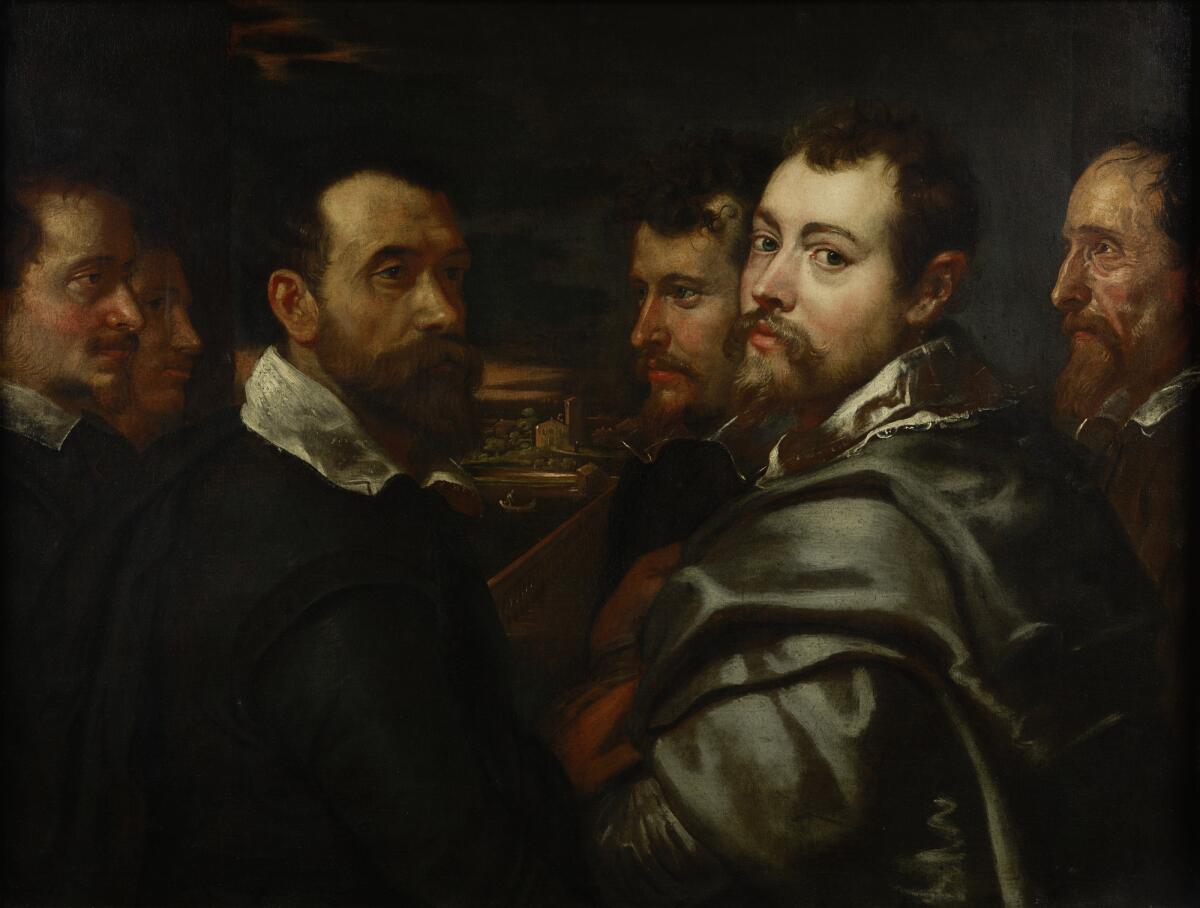
In fact, “Rubens: Picturing Antiquity” is a good example of the fruits of museum labor that typically fly under the public radar. Co-organized by Davide Gasparotto and Anne Woollett, paintings curators,
and Jeffrey Spier, senior curator of antiquities, it represents extensive research into diverse Getty collections. (It’s the museum’s third Rubens-focused show.) Baroque paintings and ancient sculptures are further interwoven with books and engravings, many from the vast holdings of the Getty Research Institute.
Simply moving a painting from one place to another can dramatically alter the way you see it.
There’s also considerable material not often given prominence but remarkably influential: Carved gems, cameos and bronze coins carry visual information at modest scale as surely as a larger-than-life marble figure of Venus does — and sometimes more so, given their convenient portability.
Two years ago, the Getty quietly acquired a tiny ancient amethyst, less than an inch high, masterfully engraved with a bust of bearded Athenian statesman Demosthenes, brow furrowed and eyes set. Widely considered the most important Greek-related object of its kind to have survived the last two millennia, it is the rarest of the rare — an ancient sculpture signed by the artist, Dioskourides, a court artist to Emperor Augustus and the most celebrated gem-carver of the age. Rubens is believed to have marveled over it during a visit to the collection of Lelio Pasqualini, a Bolognese antiquarian living in Rome.
Rubens is also thought to have owned one oversize gem on view — a foot-wide plaque from the 4th century, framed in 1628 with semiprecious stones. It shows in low relief Emperor Constantine riding in his chariot and trampling enemies, all while being crowned with a laurel wreath by a Winged Victory swooping in overhead.
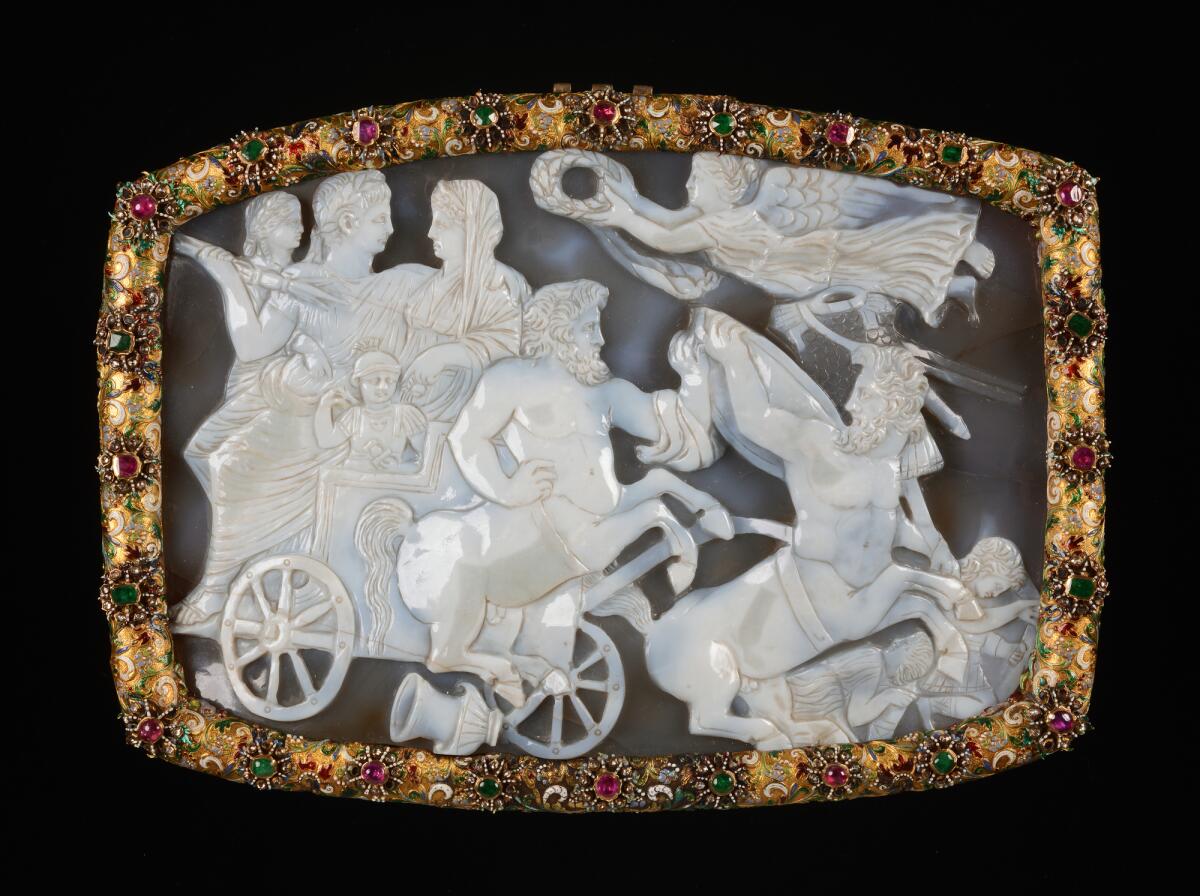
The elaborate, bejeweled gold frame indicates the degree of reverence afforded to the ancient object. Its subject matter hints at one reason why Rubens was so fixated on classical history: Constantine was the first Roman emperor to throw polytheistic paganism overboard in favor of the monotheism of Christianity.
Thus began the slow but steady transformation of Rome from the seat of ancient imperial power to the modern home office of the Catholic Church. As Rubens worked, the tumultuous Counter-Reformation fight against Protestantism was shedding rivers of blood across Europe. The painter marshaled the authority of history in service to contemporary politics.
For an art of political theater, informed knowledge of classical antiquity helped mightily. Not for nothing was the brilliantly skilled painter also revered as a masterful international diplomat.
An affectionate portrait of his friend John Gaspar Gevartius juxtaposes a bust of Marcus Aurelius, the ancient Stoic philosopher-king, with the humanist literary scholar, pen poised over a thick sheaf of paper. The sculpture doesn’t merely stand idly on the writer’s desk but instead stares fervently, almost pleadingly, into Gevartius’ eyes, as if imploring him to absorb the lessons of Pax Romana, an age of relative peace and stability for the Roman Empire over which Aurelius ruled.
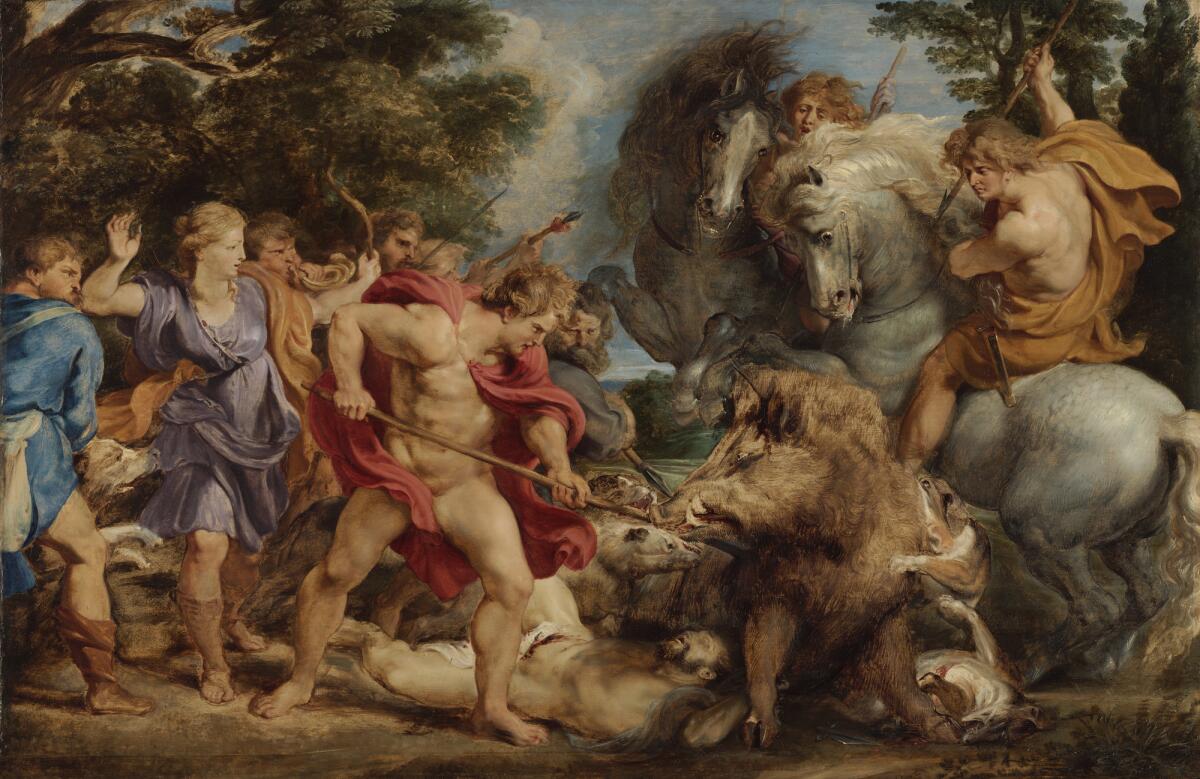
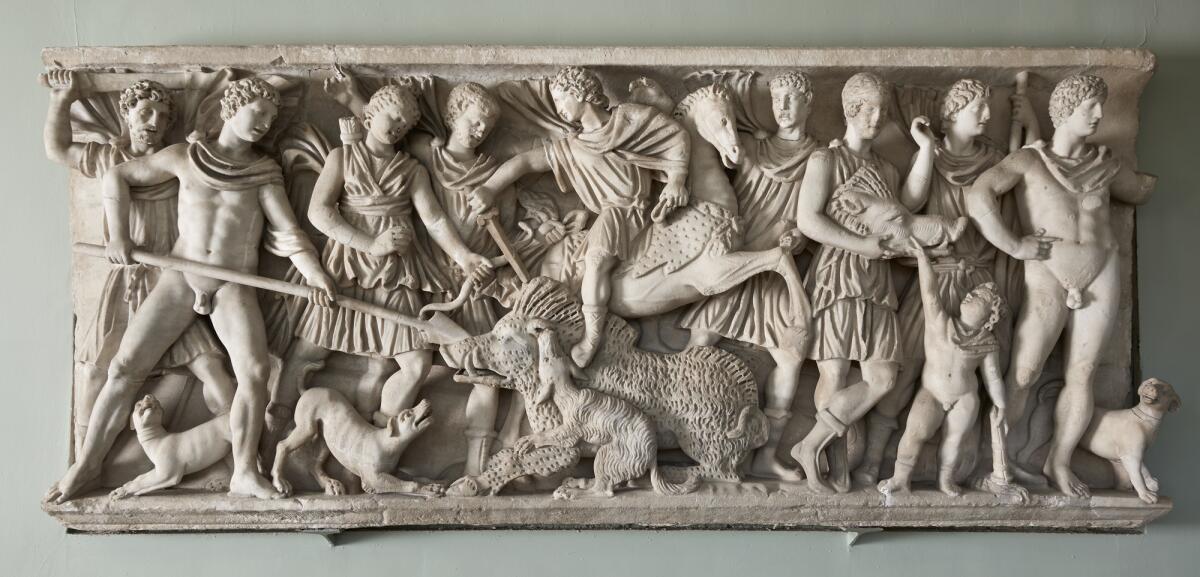
Rubens was born in the predominantly Protestant town of Siegen, east of Cologne, Germany, one of several children of Maria Pypelinckx and Jan Rubens, a city official. He converted to Catholicism after his father’s death — an irony of sizable proportions, given Jan’s deeply felt Calvinist commitments. Those included condemnation of just the sort of graven imagery his son would later master for the Church of Rome and its royal cohorts in Habsburg Spain.
Talk about rebellion against your parents.
Rubens traveled to Italy in 1600, when he was 23. He stayed for eight years — in Venice, Mantua, Florence and especially Rome — hoovering up the artistic achievements of everyone from Titian and Leonardo da Vinci to Raphael and Caravaggio, welding them to his own bravura talents. The bluish-gray skin in his sensational painting of a crucified Jesus’ icy corpse, a personal favorite in the Getty’s permanent collection, sends the ruddy protagonist in Caravaggio’s “The Entombment” into a deep freeze.
However, as the show demonstrates — apparently for the first time in a museum exhibition — the art and literature of Roman antiquity were a decisive focus.
That big carved gem of Emperor Constantine’s triumphal procession is installed near five of Rubens’ oil sketches for insanely inventive decorations at an elaborate festival he designed in Antwerp to greet the Cardinal-Infante Ferdinand of Austria, military victor over Protestant forces. The gem’s swooping Winged Victory is a recurring feature.
The Getty’s own exceptional Rubens panel painting of “The Calydonian Boar Hunt” is paired with a famous 3rd century Roman sarcophagus the artist had seen. The sarcophagus’ high-relief frieze is an idealized vision of Greek heroes felling the terrorizing monster in a mythic tale. Rubens, raising the temperature of the scene, amplifies the idealization by transforming the almost stately frieze into a blockbuster drama of good supplanting evil.
The incredible composition is like something out of the Marvel Cinematic Universe.
Meleager, whose spear provides the final deathblow, has been moved from the left side of the marble composition to a central position in the painting. With expressive brushwork, the muscular superman’s dynamic thrust, magnified by the serpentine twirl of his crimson cloak, is paired with the flying fur on the fearsome boar’s snarling head.
A lesser artist would leave it at that. But not Rubens. Look closely: The furious point of contact between man and beast is crowned by a preternaturally calm bit of verdant Arcadian landscape peeking through — you practically expect to hear the chirp of bluebirds — all ringed by the vivid counterpoint of snarling dogs, whinnying horses and a gasping victim being trampled under sharp hooves.
A serene eye is laid at the center of the visual storm. When the monster is vanquished, the promised harmony glimpsed in the pastoral distance will prevail.
Easily the show’s strangest work is a monumental canvas of a pagan myth from Ovid’s “Metamorphoses” — “The Discovery of the Infant Erichthonius,” a future ruler of Athens, represented as a baby with serpent’s tails for feet. Sequestered in a small woven basket opened by a fleshy cluster of women, young and voluptuous or old and weathered, the pagan infant is a veritable Moses plucked from the bulrushes.

Here the scene is presided over by a fountain statue of Diana of Ephesus, multibreasted cult goddess. This female image of fruitfulness is matched across the painting’s 10-foot expanse by a menacing herm of Pan — the god of the fields, symbol of fertility and, according to Plutarch, the only Greek deity who dies — peering out from the bushes.
In an essay in the show’s excellent catalog, Getty paintings curator Anne Woollett smartly compares the composition of doting figures clustered around a radiant infant to traditional pictures of the adoration of the shepherds at Christ’s nativity. I’d add a question: For layered allusions to the discovery of Moses and the birth of Jesus, did Rubens tuck in the mortal god Pan as a sign of Christian prophecy?
“Barbarism vanquished” might be said to be the overarching political theme that drove Rubens’ attentiveness to the complexities of Greco-Roman antiquity. Classicism doesn’t generate much excitement these days, even though there is plenty of barbarism to go around, but the concise and revealing Getty show digs deep.
'Rubens: Picturing Antiquity'
Through Jan. 24. Closed Tuesday.
Getty Villa, 17985 Pacific Coast Hwy., Pacific Palisades.
(310) 440-7300; getty.edu
More to Read
The biggest entertainment stories
Get our big stories about Hollywood, film, television, music, arts, culture and more right in your inbox as soon as they publish.
You may occasionally receive promotional content from the Los Angeles Times.
